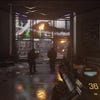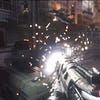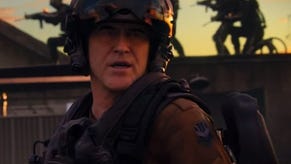Advanced Warfare is COD's biggest technological leap since Call of Duty 2
The series has evolved, but is the signature 60fps gameplay in jeopardy?
PS4 and Xbox One launch title Call of Duty: Ghosts arguably didn't do enough to show the next-gen difference. Even with tricks such as dynamic lighting and tessellation to show for the generational leap over the last-gen releases, the Xbox One's flat 1280x720 output remains a sore spot in image quality comparisons - and while the PlayStation 4 hits genuine 1080p gold (once patched), frame-rate issues and tearing stand at odds with the fluidity of earlier games on Xbox 360. But more important than the basic rendering metrics is the feeling that Ghosts iterated upon the existing formula as opposed to offering an authentic next-gen vision for the series. With the full unveiling of Advanced Warfare at Microsoft's E3 conference, do we now at last have a sign of true progress in the Call of Duty franchise?
Developed by the original Dead Space talents at Sledgehammer Games, the team brings its flair for authentic futuristic worlds to the most popular annual series of the moment. Focusing primarily on Xbox One, PS4 and PC, it's also the studio's first opportunity to produce a game on its own terms. Activision is conferring on it an unusually long three-year development window for the project, hoping for a series refresh on a par with Infinity Ward's 2007 Modern Warfare revolution. No pressure, then.
In a recent interview with Edge, studio co-founder Michael Condrey promises Advanced Warfare goes far beyond the usual engine rejigging of previous releases. This time, a majority of the code is designed from the ground up, with only a few lines of legacy code remaining. "We have new rendering, animation, physics and audio systems. This is Sledgehammer's new COD engine," he says. "The new tech that is driving our lighting and rendering engine couldn't have happened on last-generation [machines]."
At first sight, the E3 demo is an undeniably impressive leap in terms of aesthetics, with hover-bikes, mobile barricades, plus an exoskeleton suit allowing for jet-powered strafes and double-jumps. An in-game holographic HUD is also added, as flaunted by the studio's earlier work on Dead Space, removing the traditional overlays to show remaining ammo on the rifle itself. It's a stylish touch that fits nicely with the 2056 setting - but there's much more going on here.
Focusing on the E3 reveal's Induction mission, set to the backdrop of a besieged Seoul, we can once again verify a resolution boost over Ghosts. Exact metrics are hard to pin down based on our media, but it remains in the region of the initial 1568x882 measurements we gleaned from the reveal trailer, with the pixel ratios ruling out anything higher than 1600x900. So for Xbox One, we're still looking at a minimum 50 per cent jump in pixel throughput over last year's 1280x720 return. Indeed, the higher base image quality ultimately puts less responsibility on post-processing to cater for aliased edges. However, based on the performance profile of the non-final E3 build, such fidelity comes at a price.
Given that Ghosts could wobble somewhat from the series' ballpark performance on Xbox 360, we're disappointed to see that this initial showing of Advanced Warfare backtracks even further. The numbers look pretty uncharacteristic of any entry in the series so far, with performance only glancing on 60fps during the opening pod landing. Progressively, as play moves from tame alleyway pop-shots to roaring city-street battles involving swarms of flying drones and mechs, we go down from the 40fps range to the 30s. Needless to say, we have not seen how PlayStation 4 measures up, but remarkably, there are moments in the demo when the Xbox One's refresh at E3 is low enough that certain sections could possibly benefit from a 30fps cap.
The E3 build also presents some screen-tear, too; the odd flicker here and there cropping up in the top third, though rarely enough to catch the eye. We've seen far worse, but given the series' steadfastness in holding v-sync in its earliest titles, it's a slight shame image quality takes a hit where a big storm of effects clutters the screen.
How all this translates to the multiplayer experience, which tends to simplify the scope of level design to better performance, is yet to be revealed. But given that this build would probably have been assembled before Sledgehammer acquired access to the crucial June XDK from Microsoft - allowing the studio access to the new 10 per cent allocation of GPU bandwidth previously reserved for Kinect - there's clearly scope for many improvements between now and its November release.
Alternative option:
Curiously, there are two different rendering modes at play here: while gameplay runs with an adaptive v-sync that introduces tearing, in-engine cut-scenes play out without any issue. Without so much as a camera cut, this early demo points to an automatic switch - to prioritise either controller response or visual polish where player input isn't required.
Besides the resolution boost, another massive upgrade from Ghosts is the use of a pristine motion blur effect - of both the full-screen and per-object varieties. Where before its implementation showed heavy, crude banding across its trails, and was limited to spinning helicopter blades or stun grenades, Advanced Warfare's heavier approach adds to the game's cinematic flourish. Be it soldiers jet-boosting between ledges, reloading a rifle, or strafing to the side of an oncoming drone swarm, the game now at least looks far closer to our idea of a next-gen title.
This motion blur also dials up or down in intensity depending on whether it's a gameplay segment or cut-scene. The scripted opening sequence inside an escape pod shows this off best, where as well as having v-sync fully engaged, it uses a stronger variation of motion blur for each camera sweep. The variable 30-60fps performance is disguised to an extent by the heightened effect, blending each frame into the next - but for the sake of clarity, the effect is reined in during player-controlled shoot-outs.
At Seoul's hectic, war-torn city centre we see the battle isn't just fixated on our hero, Mitchell. Giant mechs trundle across his path and torpedo missiles rip through its skyscrapers; it's scripted chaos with little of the emergent sandbox gameplay enjoyed in shooters like Battlefield 4 - but even so, it dictates the surrounding action in the most appetising way possible. At least based on the demo slice shown, the linear Call of Duty template is being adhered to here for good reason.
In terms of effects, it's not a radical mix-up from Ghosts' already explosive repertoire of big - if slightly two-dimensional-looking - fire emissions and black smoke. During a frenzy of missiles and combusting cars, it's hard to draw too much of a complaint from the range of effects-work running at once. Physics-driven particles are brought out best with the new shotgun, with close-range blasts demonstrating the game's dynamic lighting against the gun's shaft. Reflections are incredibly well handled too, with a full screen-space approach allowing neon sign-posts to be mirrored across puddles of water - and likewise, aircraft show up against the lengths of each skyscraper.
In this sense, all the best of Ghosts makes it back in and then some. Based on Advanced Warfare's demo build, textures look crisper than ever before when viewed up-close, with physical-based rendering affecting lighting across each surface. According to the team's art director Joe Salud, speaking to Edge in its latest issue, the team now use a method that "measures exactly the specular responses [of a surface], then we measure the base colour so we can get these results that are more scientific." From here the team tweak overall exposure, with each surface reacting in a more realistic manner than a typical bump-mapped approach would allow.
As a result, world lighting in the E3 demo build takes on a near photo-realistic appearance - an improvement that crosses over to shadow rendering too. Unlike the last game, there's no sign of the rough stair-stepping that blighted Ghosts' shadows at a distance. Shadow maps are subject to a more subtle filtering method this time, now avoiding any noticeable cascades and giving a more consistent blend between light and shade across a scene.
With hover-tanks, drones and laser-guns promised, Sledgehammer Games also boasts big ambitions for the game's sound stage. Adopting a new audio engine, Advanced Warfare's focus on Xbox One and PS4 hardware means the restrictive RAM barrier of last-gen consoles is broken though. This makes room for a broader palette of samples across its many new vehicles and guns, sound also being processed in real-time for moving vehicles based on momentum and the acoustics of the level.
Equally impressive is the game's new motion capture system, as showcased with the E3 demo's limb-chopping climax. According to animation director Chris Stone, the team's cutting-edge HD cameras are entirely new to the industry, with even James Cameron intent on utilising the same technology for Avatar 2. With these to hand, actors are asked to deliver over 200 facial expressions for use during the game, giving the developers the ability to accurately generate just about any expression a character can possibly make. For an additional layer of realism, Sledgehammer took more captures from Kevin Spacey to ensure that his performance in-game is just right.
And sure enough, each actor's idiosyncrasies come across convincingly during the demo, rendered with smooth, tessellated in-game models. The hiring of a household name like Spacey is a real litmus test, too; earlier videos show the use of approximated subsurface scattering, which produces a more realistic, layered look to skin. Cinematics have an air of extravagance about them this time then and, with any luck, the huge expense will reinforce a story where characters are put centre-stage.
From this early reveal of Advanced Warfare, we're left to consider some clear highlights in advance of its November release. Call of Duty: Ghosts iterated upon existing engine tech - realistically the only option available in a compressed development window - but Sledgehammer Games certainly seem intent on making the most from the new hardware. Its E3 build shows huge promise, with a materials-based lighting system and revamped motion capture tech in particular pointing - at last - to a genuine next-gen entry in the series.
While the resolution increase over Ghosts on Xbox One is obviously welcome, the 30-40fps frame-rate issues found in the E3 demo are clearly a concern bearing in mind how greatly the series' interface between player and game relies on low latency controls - practically demanding a 60fps refresh. This has all the intentions of being the most pristinely presented, cinematic Call of Duty title yet, but the worry here is that Sledgehammer may not hit the 60fps target while raising the bar visually.
Of course, how the final code stacks up come its 4th November release is something we're eager to discover. Advanced Warfare is a gorgeous-looking game in its current state, but our hope is that the team is concentrating its efforts on optimisation, an area where there are some positive signs on the horizon. Resolution is something that can, as ever, be scaled back as a last resort. But there's also the not-so-small matter of GPU resources being freed from Kinect duties, which could go some way to making up the difference. Just how great an impact optimisation and XDK revisions will have on the final game remains to be seen, but hopefully Sledgehammer Games will get the balance right and deliver an advanced next-gen engine with the slick performance that has defined the series.






























